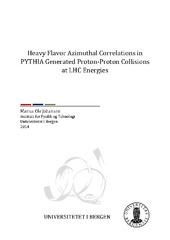| dc.description.abstract | The ALICE detector at CERN is a promising tool for the study of the Quark-Gluon Plasma (QGP), an exotic state of matter thought to be present in the early Universe. The study of partonic energy loss reveals vital information about the interaction between quarks and gluons in the QGP. Heavy quarks are used as probes since they are created in initial hard scattering processes and consequently undergo the entire evolution of the created medium. Recent studies of hadrons originating from fast light quarks show a suppressed particle yield in events where the QGP is present. For light quarks, the preeminent energy loss is due to radiative energy loss. Heavier quarks are not as sensitive as light quarks to this suppression, but experiments indicates a particle suppression originating from heavy quarks to the same yield as light quarks, implying radiative energy loss is not the only contributor to the partonic energy loss. A study of this energy loss can be performed by utilizing angular correlations of heavy flavor mesons. Alongside yielding important input on energy loss models, the angular correlations also provide a base-line for Pb-Pb collisions and crucial pQCD tests. In this thesis, the azimuthal correlations of electrons originating from heavyflavored hadrons and neutral D mesons of PYTHIA simulated proton-proton collisions at several momentum cuts are analyzed. In particular, a new method of obtaining the azimuthal correlations is presented with the aim of both increasing the number of statistics as well as check if there are any significant changes compared to the distributions obtained through the current means. Azimuthal correlations of charm and beauty quarks at different momentum cuts are also analyzed. Due to the low statistics regarding the production of heavy quarks, the analysis will be performed on both a minimum bias run as well as an enhanced sample. In the 1st chapter, a brief introduction on quarks and matter will be presented alongside some important properties regarding Quark Gluon Plasma. The following chapter will emphasize on the experimental setup at CERN and an outlay of the ALICE detector. Chapter 3 will cover the some important topics regarding the object oriented software AliRoot as well as some fundamental event generators and the main ingredients of an AliAnalysisTask, which is the actual analysis macro. Various heavy flavor production mechanisms and the corresponding Feynman topologies are discussed in Chapter 4. In the succeeding chapter, PYTHIA will be presented with an emphasis on particle production and some examples of generated distributions. Chapter 6 contains the main analysis of this thesis, namely heavy flavor azimuthal correlations. The various steps of the analysis macro will be introduced, as well as the results from this analysis. A conclusion is given in the final chapter. | en_US |
